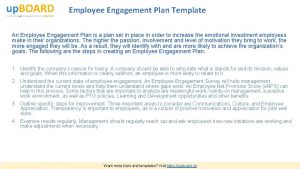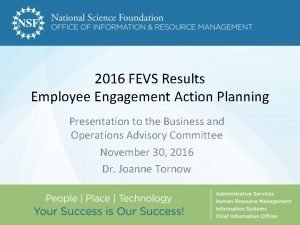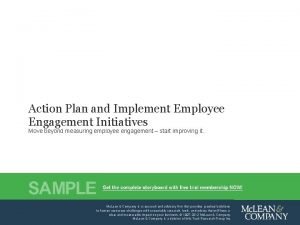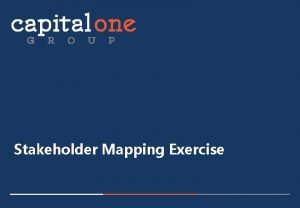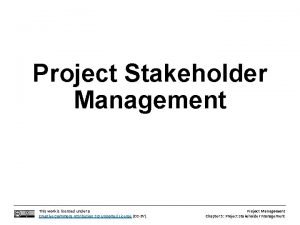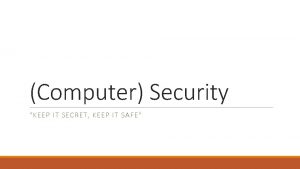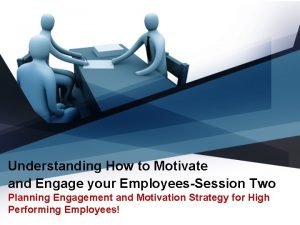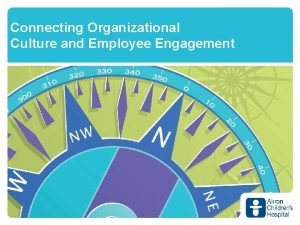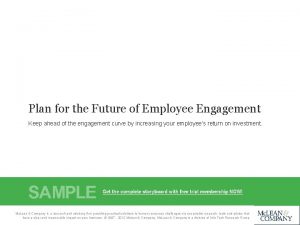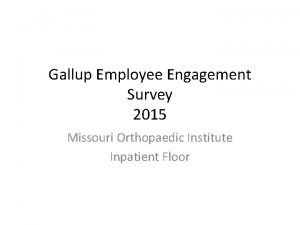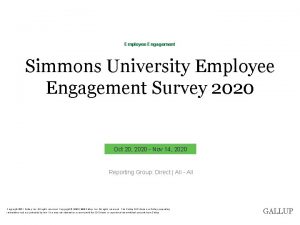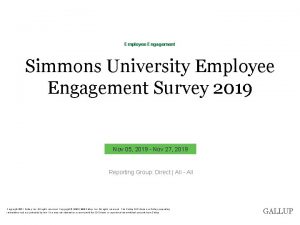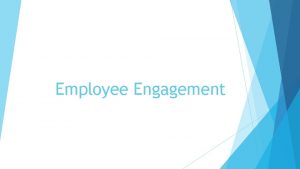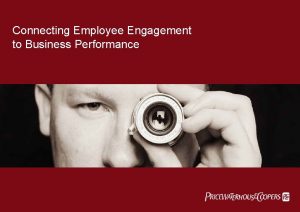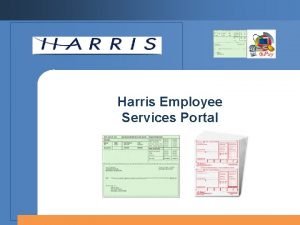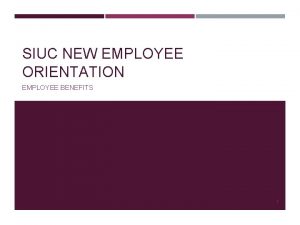Plan for the Future of Employee Engagement Keep












- Slides: 12

Plan for the Future of Employee Engagement Keep ahead of the engagement curve by increasing your employee’s return on investment. Mc. Lean & Company is a research and advisory firm that provides practical solutions to human resources challenges with executable research, tools, and advice that will have a Mc. Lean & Company is a research and advisory firm providing practical solutions to human resources challenges©via executable research, tools and advice that clear and measurable impact on your business. 1997 -2012 Mc. Lean & Company. have a clear and measurable impact on your business. © 1997 - 2012 Mclean & Company. Mc. Lean & Company is a division of Info-Tech Group Mc. Lean & Company is a division of Info-Tech Research Group. Research Inc. Mc. Lean & Company 1

Introduction As employee engagement becomes more prevalent in the world of work, it will also begin to evolve. Keep up with its evolution to face common challenges. This Research Is Designed For: ü Organizations who have had success with traditional engagement surveys in the past, and are looking to stay ahead of the times. ü Organizations that have not implemented engagement due to lack of buy-in and are looking for an alternative strategy. ü Human Resource practitioners, managers, and senior executives endeavoring to be proactive to keep employees engaged. ü Anyone interested in employee engagement and the future of employee engagement. This Research Will Help You: ü Understand the history of employee engagement. ü Recognize the changes in the workforce, and their impact on employee engagement. ü Reframe how you think about engagement to face its common challenges. ü Create a mutually beneficial relationship with employees. ü Be proactive to keep employees engaged in the future. Mc. Lean & Company 2

Executive Summary • It is proven that employee engagement positively impacts employee performance, retention, and creativity. • However, changes in the working world are making employee engagement more challenging. These changes include poor economic conditions, increased globalization, changing demographics, and decreased loyalty for both employees and organizations. • These changes and challenges should lead all organizations to ask, “what’s next? ” If engagement was an extension of satisfaction, what will evolve from engagement over the next decade? • Engagement 2020, which we call “Investment, ” considers the return on the investment of the employee. • Investment refers to a mutually beneficial relationship in which the employee consciously contributes those things that the organization values (e. g. skills, time, effort), and in return, the organization invests in what the employee values (e. g. compensation, development, recognition). • The degree of the employees’ investment depends on the returns they receive from the organization; start maximizing the return for employees to ultimately improve the return of them. • Investment is more rational and less emotional than engagement. It is more about behaviors, and less about feelings, and therefore has a more direct impact on the organization’s bottom line. For these reasons, it is more likely to catch the attention of the CEO and other executives. • Investment does not negate engagement. In a best-case scenario, employees are engaged and invested. These employees consciously deliver their best performance because they believe that their returns are worth the investment, plus they are emotionally connected to the organization and their role. • Focusing on employee investment in your organization does not mean you have to halt or revamp your engagement program. Investment simply reframes the “whys” behind particular actions. Investment is more conscious on the part of the organization and the employee. Mc. Lean & Company 3

Make the case What’s in this Section: • Despite the benefits of engagement, changes in the workforce are making it more difficult to improve your workforce’s engagement level. Sections: Make the case What’s next? Get started • Lack of buy-in from the executive team is cited as the top obstacle for implementing an engagement program. • As engagement becomes more prevalent, it will also begin to evolve. Stay ahead of the engagement curve to keep up and overcome common obstacles. Mc. Lean & Company 4

Job Satisfaction, first introduced in the 1930 s, was replaced by employee engagement in the 1990 s Mc. Lean & Company defines Job Satisfaction and Engagement in the following ways: Satisfied employees feel comfortable, and are generally happy that their needs are being met. vs. Engaged employees feel energized, passionate, dedicated, and are highly involved with their work and the company. A history of Job Satisfaction and Employee Engagement: Job Satisfaction 1935 Employee Engagement 1990 1997 - 2002 2003 - Present • The term “Job Satisfaction” • William A. Kahn at Boston • Both business researchers • Employee engagement has is first introduced by Robert University is the first to and academic researchers been highly researched Hoppock. study engagement at work. link employee engagement to over the last decade. • Defined as “any • He explores the effects of business results. • There are few people in combination of meaningfulness, safety, and • Harter et al. find that higher business that haven’t heard psychological, physiological, availability on employees’ levels of engagement are about employee and environmental engagement in their work. associated with greater engagement, and many circumstances that cause • Results show that all three customer satisfaction, organizations have tried to a person to truthfully say, conditions exhibit significant productivity, and profit, as do something about it ‘I am satisfied with my job. ’” positive relations with well as decreased turnover. through an engagement Source: Harter, James K. ; Schmidt, engagement, with survey. Frank L. ; Hayes, Theodore L. meaningfulness displaying • Yet, only a third of the strongest relation. workforce is engaged. Mc. Lean & Company 5

The list of benefits of employee engagement is long, but three outshine the rest: Performance, Retention, and Creativity The Employee Engagement Value Chain Engaged employees drive: Performance (Effectiveness + Efficiency) Performance, Retention, and Creativity drive: Increased Revenue Profitability & Shareholder Value Retention Decreased Costs Creativity Increased revenue and decreased costs drive: The Bottom Line Impact Companies with a highly engaged workforce demonstrate: • An average three-year revenue growth of 20. 1%, much higher than the 8. 9% peer average. • A three-year earnings growth that is three times higher than peer average. Source: Bloomberg Businessweek In 2010, organizations with engagement levels that were: • Higher than 65% posted total shareholder returns 22% above the average. • Less than 45% posted total shareholder returns 38% below the average. Source: Trends in Global Employee Engagement, Aon Hewitt, 2011 Note: For more information on employee engagement, refer to the Mc. Lean & Company solution set, Make the Case for Employee Engagement. Mc. Lean & Company 6

Despite the known benefits of engagement, the economy and globalization make it challenging for organizations to improve it Economic uncertainty causes organizations to remain cautious. The increase in globalization and teleworking means that employees are more isolated. Employees can no longer rely on their organization for security, and organizations can no longer rely on employees to be loyal. Teleworking has increased dramatically in the last few years and will continue to increase. Additionally, geographic expansion is a top priority for small to midsized companies. • During the economic downturn in 2008, many organizations cut people and programs. Even though the economy has improved, organizations aren’t reinstating these investments. • Twenty years ago, it was common practice for employees to stay at the same company for their entire career. • Such tenure is no longer the case. Employees and organizations are less loyal. Challenge: You can’t count on employees to have an emotional bond with their organization, which is at the core of employee engagement. Furthermore, CEOs still aren’t concerned by what they consider to be “soft” issues. • Between 2005 and 2009, teleworking on a regular basis (1 – 2 days per week) grew by 61%, and the number of regular teleworkers is expected to increase to 69% by 2016. Source: Telework Research Network • Eighty-four percent of respondents who work for companies with under $500 M U. S. in annual revenue said that globalization is a major focus for their company either now or within the next five years. With this comes globally dispersed teams, and less face-to-face interactions. Source: The Economist Intelligence Unit, 2009 Challenge: Highly engaged organizations typically succeed at building and maintaining authentic, trusting relationships. Dispersion of employees makes engagement through relationships more difficult to obtain. Mc. Lean & Company 7

Changes in employee expectations and the talent market further complicate the endeavor to increase engagement Employees’ expectations are changing. Changes in the talent market mean employees aren’t staying with organizations as long. Increasing diversity in the workforce, including women and Gen Ys, has brought a new perspective. Organizations are relying on contract jobs instead of fulltime positions. • Women have more responsibilities outside of work. • Gen Ys have different opinions about when, where, and how they do their best work. • In Canada: Statistics Canada reported that 52% of all temp jobs were contract jobs in 2009; 25% of those were professionals. • These two groups are becoming larger and more prominent participants in the Western workforce, and they’re looking for increased work/life balance. • In the U. S. : Mc. Kinsey & Co. found that 65% of U. S. corporations have restructured their workforce and none plan to go back to pre-recession employment. Furthermore, all employees, regardless of their age, are looking for increased development opportunities, more feedback, more teamwork opportunities and more opportunities to give back to the community. Challenge: What organizations need to do to engage employees has less to do with taking care of them, and more to do with providing options. Employees are just as interested in what they can take away from the organization, as what they can get while they are there. Source: Ray Williams, 2012 Employees realize that staying at an organization for decades is actually a detriment to their career. Recruiters are changing their opinion on “job hoppers, ” and instead view employees that stay at an organization for many years as less marketable because they lack diversity in their experience. Challenge: Organizations invest in their employees’ engagement, and by the time they are beginning to see the return, employees leave. It is hard for organizations to build engagement momentum because there are new people constantly entering the mix. Mc. Lean & Company 8

Within organizations, lack of executive buy-in is cited as the most significant obstacle impacting engagement Obstacles impacting employee engagement The reality: • Organizations are stretched very thin, and unless executives see the tangible ROI of implementing an engagement program, they won’t be motivated to invest. Lack of buy-in from the executive team Unwillingness to change current procedures • Both senior managers and HR need to completely buy-in to the idea of engagement, which is often still viewed as a “touchy-feely” HR topic. Lack of the necessary resources Not enough positive impact when conducted in the past Lack of buy-in from HR management Is there a different way of thinking about people to make this topic less “soft”? 0% 5% 10% 15% 20% 25% 30% 35% 40% Source: Mc. Lean & Company, N = 26 % selected as high impact Basically what I’ve seen over the last couple of decades with employee engagement is that half the companies out there aren’t doing anything about it, and the half that are running surveys or think they’re doing something, are not successful for a variety of reasons. -Kevin Kruse, author of Employee Engagement 2. 0 In people management terms “being left behind” means being unable to attract and retain the best and brightest in your field. - Karen Schmidt, Engaging Leadership Expert and President of Let's Grow! How can employee engagement evolve to address these challenges? If satisfaction evolved into engagement, what will engagement look like in the year 2020? Keep reading for Mc. Lean & Company’s solution to your engagement challenges. Mc. Lean & Company 9

What’s next? What’s in this Section: • Investment is a mutually beneficial relationship between the employee and employer. • Organizations should focus on improving the Sections: Make the case What’s next? Get Started employee’s ROI; the organization’s ROI will increase in return. • Investment doesn’t replace engagement. Organizations should strive to have employees that are both invested and engaged. Mc. Lean & Company 10

Engagement 2020, which we call “Investment, ” considers the return on the investment of the employee Engagement was an extension of satisfaction and investment is an evolution of engagement. Satisfaction Past Engagement Present Investment Future Investment is a mutually beneficial relationship in which the employee consciously contributes those things that the organization values (e. g. skills, time, effort), and in return, the organization invests in what the employee values (e. g. compensation, development, recognition). Engagement: vs. Investment: • Can fluctuate. One event can influence the degree to which an employee is engaged in a particular moment. • The degree to which an employee is invested is more stable than engagement. • Engagement can be subconscious – in most cases, an employee doesn’t consciously decide to be engaged or disengaged. • Investment is a conscious decision by the employee – they decide to what degree they will invest in the company based on the promise of an output. • A relationship between the employee and employer. Thought of as a “soft” topic. • A transaction between the employee and employer. More calculated and “hard” than engagement. • Employers play an active role and the employee plays a passive role, in most cases. • Investment is much more two-sided than engagement: the onus is equally on the employee and employer. Mc. Lean & Company 11

Mc. Lean & Company Helps HR Professionals To: ü Empower management to applyü HR best practices ü Develop effective talent acquisition & retention strategies ü Build a high performance culture Maintain a progressive set of HR policies & procedures ü Demonstrate the business impact of HR ü Stay abreast of HR trends & technologies Sign up for free trial membership to get practical solutions for your HR challenges "Mc. Lean & Company provides practical research, tools and advice covering the entire spectrum of HR & Leadership issues to ensure you experience measurable, positive results. " • - Rob Garmaise, VP of Customer Experience Toll Free: 1 -877 -281 -0480 hr. mcleanco. com Mc. Lean & Company 12
 Employee engagement action plan template
Employee engagement action plan template Employee engagement action plan presentation
Employee engagement action plan presentation Mclean and company engagement survey
Mclean and company engagement survey Future simple future continuous future perfect
Future simple future continuous future perfect Future perfect simple and continuous
Future perfect simple and continuous Keep satisfied manage closely monitor keep informed
Keep satisfied manage closely monitor keep informed Power interest grid
Power interest grid Keep it secret keep it safe
Keep it secret keep it safe Employee engagement programs examples
Employee engagement programs examples Evpa
Evpa Objectives of employee engagement
Objectives of employee engagement History of employee engagement
History of employee engagement Gallup survey employee engagement 2015
Gallup survey employee engagement 2015
